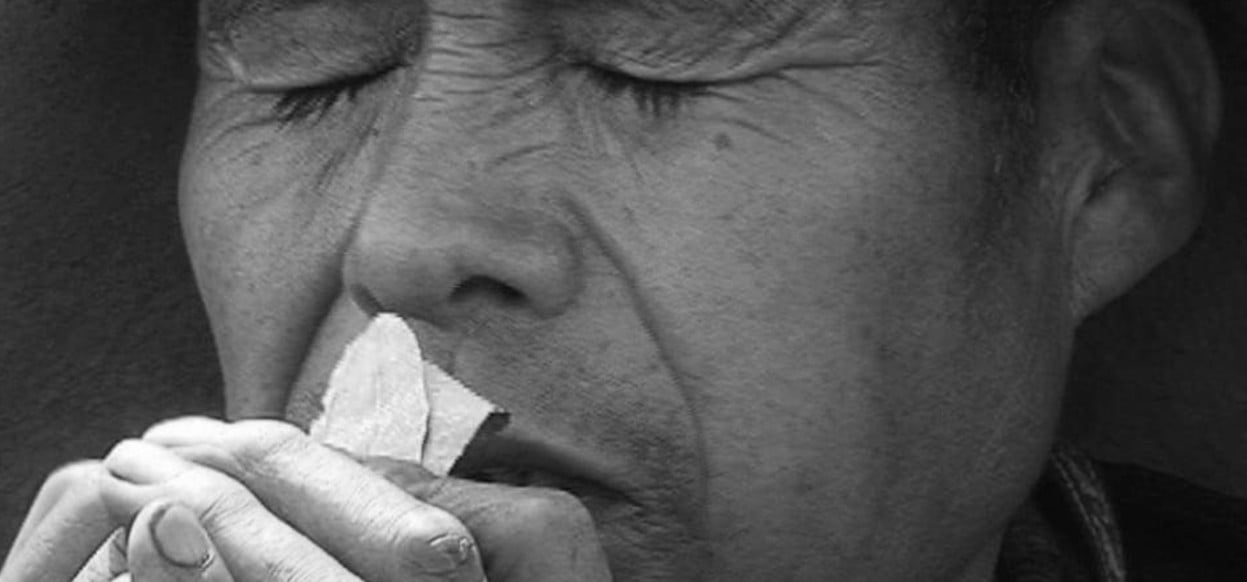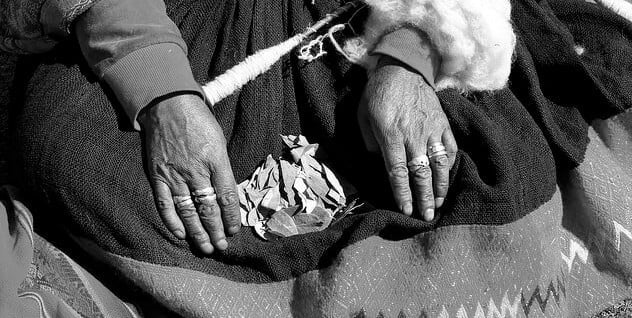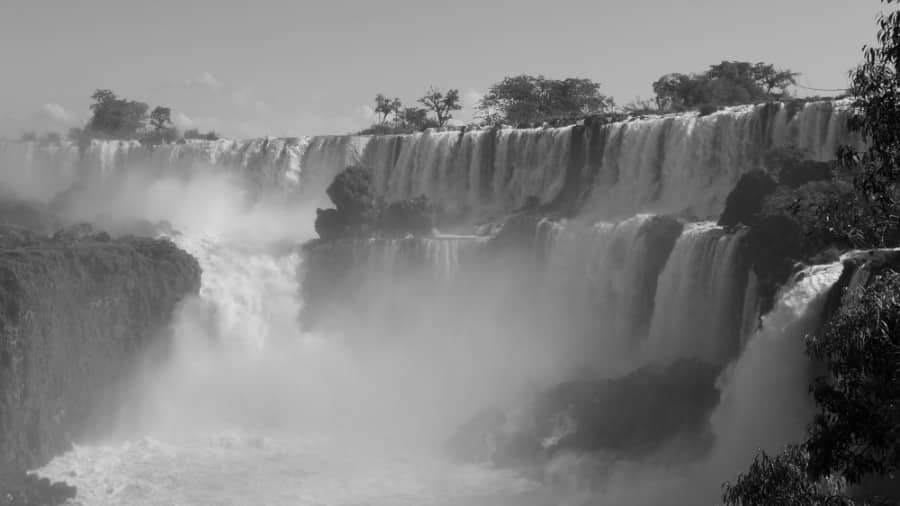Rapa Nui offers a world of inquiry that have remained unanswered for centuries. Questions abound surrounding the origins of the people and their culture, the Moai statues, the Tangata manu – Birdman cult and the history of the Islands racial extermination, ecological and natural disasters.
Discover Myths and Legends of the Moai on Rapa Nui-The Easter Island.
In this Article
The unique culture that emerged on the Easter Island produced more than four thousand petroglyphs and moai 🗿, the imposing monolithic statues carved in stone. The art on Easter Island both embodied and signified the supernatural power of the gods and the chiefs who were believed to be their direct descendants.
To harness this power, their artists created small wooden images and Moai, enormous stone images, of diverse supernatural beings, who mediated between the divine and material worlds and sought to tap the supernatural power, or mana, of the gods for the benefit of human society.
The island’s enormous carved stone moai statues, have given the isolated island allure for generations. Myths and Legends of the Moai on Rapa Nui-The Easter Island and speculation abound, Jacob Roggeveen writes:
“The island is planted with monstrous great statues, the work of I don’t know what race, today degenerate or vanished; its great remains an enigma.”
THE MOAI OR AHU MOAI
JACOB ROGGEVEEN
The Dutch explorer Jacob Roggeveen named the Easter Island, he first spied it on Easter Day 1722, this tiny spit of volcanic rock in the vast South Seas is, even today, the most remote inhabited place on earth. Its nearly 1000 statues, some almost 9 meters or 30 feet tall and weighing as much as 80 tons, are still standing. Jacob Roggeveen reported in his ship log of people praying to the statues:
The people had, to judge by appearances, no weapons; although, as I remarked, they relied in case of need on their gods or idols which stand erected all along the sea shore in great numbers, before which they fall down and invoke them. These idols were all hewn out of stone, and in the form of a man, with long ears, adorned on the head with a crown, yet all made with skill: whereat we wondered not a little.
A clear space was reserved round these objects of worship by laying stones to a distance of twenty or thirty paces.
I took some of the people to be priests, because they paid more reverence to the gods than did the rest; and showed themselves much more devout in their ministrations.
One could also distinguish these from the other people quite well, not only by their wearing great white plugs in their ear lobes, but in having the head wholly shaven and hairless.
Only Jacob Roggeveen has ever reported on someone praying to the statues, which would suggest that the statues were revered until Europeans came. Though, it was common all over the island to recycle pieces of old statues when building new Ahu platforms. This seemingly means that the moais were not seen as holy anymore when the person it represented had been forgotten.
JAMES COOK
To early travelers, the spectacle of immense stone figures, was almost beyond imagining.
“We could hardly conceive how these islanders, wholly unacquainted with any mechanical power, could raise such stupendous figures,”
the British mariner Capt. James Cook wrote in 1774. He freely speculated on how the statues might have been raised, a little at a time, using piles of stones and scaffolding; and there has been no end of speculation, and no lack of scientific investigation, in the centuries that followed.
By Cook’s time, the islanders had toppled many of their statues and were neglecting those left standing.
MYTHS AND LEGENDS OF THE MOAI ON RAPA NUI – THE EASTER ISLAND
Myths and Legends of the Moai on Rapa Nui-The Easter Island are plentiful, the Moai have been the focus of countless debates over the years, from their origin and meaning, the method utilized to transport them, and their placement on the Ahu, to the removal from their mounts.
Myths and Legends of the Moai have been transmitted orally by the natives and collected by ancient visitants. But these myths, that try to explain past events, are usually adorned by the imagination of the teller or the listener. Therefore, the historical reconstruction based on them wanders between reality and fantasy.
According to Rapa Nui mythology Hotu Matu’a was the legendary first settler and ariki mau (“supreme chief” or “king”) of Easter Island. Hotu Matu’a and his two canoe (or one double hulled canoe) colonizing party were Polynesians from the now unknown land of Hiva.
They landed at Anakena beach and his people spread out across the island, sub-divided it between clans claiming descent from his sons, and lived for more than a thousand years in their isolated island home at the southeastern tip of the Polynesian Triangle until the arrival of Jacob Roggeveen.
MYTH: On the Origin of the Moai
~ Hotu Matu’a Sends Men to Bring Moai Tautó to Easter Island. Legends and Traditions of Easter Island by Sebastian Englert
When the settlers established themselves and brought their first harvest, Hotu Matua remembered that he had forgotten to bring a stone moai from Hiva. He sended six young men with a canoe to bring the Moai named Tauto to Rapa nui. When loading, however, the men broke the Moai in two parts.

Hotu Matua had a vision of this misfortune and burst into loud lamentations. He went to the beach to await the return of the expedition.
After a few days, on the beach of Anakena, he found a fragment- the head with the neck of Tauto. It had come there by magical power and served from then on as a model for all other moai of Easter Island. The six men, however, were never seen again.
A modern story of the Moais’ Origin
~ Narrated in 2013 by 60 year-old Carlos Edmunds, from Hanga Roa, Easter Island.
When they started producing the moai, it was one of the great grandsons of Hotu Matu’a who thought of making them to represent important people who died. That’s why they made the moai. It was because of a dream that someone had…someone important. From then on, they gave instructions to make the moai.
If you visit Ranu Raraku, there is a large block of stone there; this was the first moai they started work on, but they couldn’t continue, because they didn’t know how to begin with the head, then finish with the body; so it just lay there as a stone block. This moai is called Tai Hare ’Atua, because it’s near the front, rising directly to where the moai quarry is.
So the father, who’d come up with the idea, decided to send his two sons, Miru a Hotu, and Tangi te Ako a Hotu, to go and ask how the moai are really made. This was because the wise man had known Hiva before arriving on the island. Hiva was the land they had come from with Hotu Matu’a, and there they knew how to make a moai.

So they were sent on up to see the old man. His name was Kave Heke, and he lived not far from the town, towards the coast, near the sacred Ahu Makere.
And off the two young boys went to ask Kave Heke how they were made; how to set about making a moai; what were the stages involved; something like that anyway. So the two boys arrived, hoping for an answer from the old man, who carried on with his business, without saying a word to them.
They waited for quite a while for him to say something to them, and then one of them said: “Hey, let’s go, because he doesn’t want to tell us.” It was getting late, so they started to return home. They’d got a fair way, when the old man called out to them. He told them to stop, and to listen.
And then he said: “Not to worry…just go…you have it down below”.
Well, the closest translation from the Rapanui at least is, “you have it down below”. But it’s rather difficult to translate.
As neither of the boys understood, one of them said, “Ah, let’s just go.” And a little further on, about halfway home, they came to a small forest. There’s a Puku there, which is now called Puku Repu Rei, after this episode. And one of them needed to relieve himself; to take a leak to be more exact.
So there he was, urinating, when it suddenly dawned on him. He called to his brother: “Look! This is what the old man was talking about.” And that’s when he realized; and that’s where it came from. If you look at the shape of the moai, it’s basically shaped like a penis. Later they made the face, the ears; but it’s a penis, that’s where they got the shape from, the shape of the moai.
The Ahu Moai

Beginning around 1000 AD, and for almost half a millennium that followed, [possibly between 1200 and 1500] the Rapanui culture reached the pinnacle of its achievement with the construction of vast stone monuments.
During this phase, almost 300 altars, or ceremonial sites, Ahu, were erected in homage to the ancestors. The Moai are believed by most archaeologists to represent the spirits of ancestors, chiefs, or other high-ranking people who held important positions in the history of Rapa Nui. The statues may also hold a sacred role in the life of the Rapa Nui, acting as ceremonial conduits for communication with the gods.
Though the majority of the Moai are male representations, because it is believed that all of the chiefs were men, it’s noteworthy that there are approximately twelve moais with feminine traits, such as pronounced breasts, belly or sculpted vulvas.
An ahu is a platform, most of which are located along the coast. Almost a third of the ahu are oriented astronomically: those near the coast point towards the equinoxes and those inland towards the solstices. The ahu would sometimes be very large, as can be seen from Ahu Tongariki, which is 96 metres in length.
The Ahu Vinapu, on the other hand, exemplifies the perfection achieved in mounting the moai, and in the refined smoothness of its stone slabs.
On several of the ahu, carved stone figures or moai were erected, thus constituting the so-called ahu-moai. Originally the ahu were small platforms that were then enlarged to support the moai. Over time, the moai increased substantially in size and became ever more intricate in design.
The moai were thought to be “the personification of ancestral spirits from each lineage”.
There are somewhere in the region of 1000 of these statues scattered throughout the island, most of which were carved in the quarry that lies on the slopes of the Rano Raraku volcanic crater. Over time, the craftsmen began to perfect their techniques, sculpting intricate features and increasing the stature of the figures.
Moai size and weight
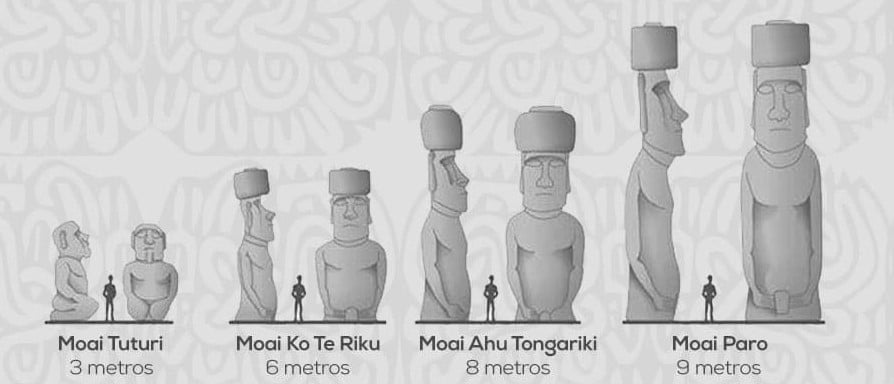
The average height is 4.5 meters and the weight of more than 5 tons.
- Moai Tuturi: it is the smallest of all. It is only 3 meters high, weighs 4 tons and is located mainly on the platform of the Rano Raraku volcano.
- Moai Ko Te Riku: it measures 5 meters, weighs 6 tons and is in the ancient Tahai ceremonial temple.
- Moai Ahu Tongariki: It measures 7 meters and weighs more than 8 tons. Its location is in the largest ceremonial center of the ancient natives, to the left of the Poike volcano.
- Moai Paro: it is the largest moai on the island. It measures approximately 9 meters and its weight exceeds 80 tons. Unfortunately this moai is fallen and broken (divided into three parts).
Archaeological discoveries have demonstrated that some moai are female, one of the woman- moai is pregnant. Many of the moai were also garnished with eyes made from white coral or stone, and pupils made from red scoria. Several scientists believe that, by giving the stone giants eyes, they would be able to radiate mana, thus protecting their clan’s lineage.
The Pukao
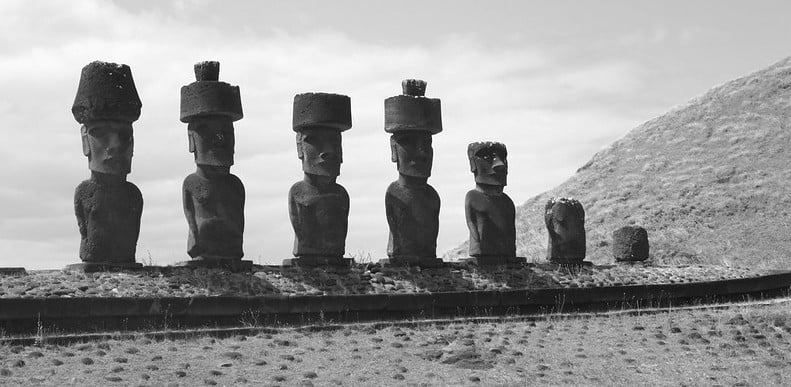
A third of the moai that were erected on ahu had a cylindrical red- scoria pukao or “topknot”. These were sculpted in the quarry at Pina Pau.
They are thought to have represented a traditional headdress, whereby the hair was tied in a bun above the head.
The pukao were the highest expression of power for some lineages, and provide evidence of the advanced engineering mastery and artistry acquired by the Rapanui. The mana (supernatural powers) was according to ancient beliefs preserved in the hair, which is why chieftains never cut their hair. Others states that the pukao resembles a hat.
How the pukao was put in place

Below are three different accounts that tell how the moai hats were put in place on top of the statues.
~ Recorded by Sebastian Englert, translated to English by Marcus Edensky in 2014
Carlos Teao Tori
This is what my grandfather Tori ‘a Papaveri said to me:
To make the moai hat reach its place, a pile of rocks was built. The hat was pushed and pushed upwards to the head of the moai.
When done, the rock pile was dismantled and the rocks were used for the ahu.
Mariana Atán
The elder Huhu Kahu told my mother:
To put the hats on top of the head of the moais, men would pile rocks and pushed the hat over the piled rocks until it reached the head.
Santiago Pakarati
Veriamo told me:
The hats of the moais were put in place in the following manner: rocks were piled, push, push upwards to reach the head.
It was tied with a thick rope of mahute, or it would fall over to the other side. That’s how they reached their place.
The three people who originally told these stories (Tori, Huhu Kahu and Veriamo) were all born before 1850, before the ancient Rapa Nui culture was destroyed.
Hoa Haka Nana- The stolen friend
One of the most distinctive features of Orongo was a basalt moai, almost 2.5 metres high; it was later named Hoa Haka Nana or Hoa Haka Na La, “the stolen friend”.

The moai is unique as it was sculpted in basalt, and because the engravings on its back symbolize the ancient culture’s continuity and change.
Believed to show the transition of the cult of the ancestors or Moai to the cult of Makemake and the birdman- ritual.
In 1868, it was taken to London aboard the English Man of War, HMS Topaz. It has since been exhibited at the British Museum. Today other Moais are also scattered through the world’s museums.
The Easter Island or Rapa Nui are an UNESCO World Heritage Site and the Moais are now protected.
Visiting Rano Raraku the moai statue querry
We visited the pits of the volcano Rano Raraku the artists’ workshop of the Moais – the volcano from whose basalt the Moais were made. On its slopes stand or lie Moais in different stages of production. From the quarry we look at the heads protruding from the earth with their empty eye sockets.
However, these are not just heads but spilled statues, only the upper third sticking out of the ground. Higher up on the mountain, another 150 unfinished sculptures are left behind, still bearing witness to the mystery.
Makemake, our knowledgeable guide explains,
“Using simple stone chisels, the tufa was worked using water from gourds, and it took about 30 years for a stonemason to complete an average-sized statue.
When finished, they went down the slope and waited for their final destination. There are a total of 276 statues ready to walk to their ahu platform on the coast.”
“Ahu means a holy place and is the rectangular stone platform on which the sculptures were built because the statues have to go to the platforms” again Makemake claims,”The statues are just walking there!”
If legends say moai walked to their ahu, there is a good chance that they did just that. Probably they “walked”, helped by human force and ropes.
Walking by Mana

~ The following is an excerpt of Luomala Katharine. Moving and movable images in Easter Island custom and myth.
From the perspective of oral tradition, a series of stories explain the reason for the moai’s shape, how they were transported, and why they fell.
As Katherine Routledge pointed out, the islanders were sure that the statues were moved thanks to mana, and responded with bewilderment at the apparent ignorance of the foreigners who were unaware of mana, that was so evident to them.
Today, many Rapanui have not been swayed in this belief, especially in explaining a moai’s location in somewhat inaccessible parts of the island. As Carlos Edmunds declares, there is only one explanation for the moai sited on cliffs:
“Mana, that’s how our history is, and that’s how it will remain, until it has been proved otherwise”.
MYTH: Walking statues
- One myth declares that a chief, often said to be the popular Tu’u-ko-ihu, had such great mana that when he ordered the stone giants to walk they set out and chose the places most convenient to themselves.
- Another states that it was Makemake, the greatest god in the island pantheon, who had sufficient mana to relocate the statues.
- Still another myth narrates that priests by continual chanting made the statues walk to where they are now. Whenever the priests stopped chanting their spells the statues halted.
- Some statues are now scattered around the island because, according to mythology, an evil spell halted their march toward the family funeral platforms for which they were destined.
- Routledge was informed that an old woman, who cooked for the sculptors of these statues, had the supernatural power to order the images to move. When the image-makers did not share their food with her she angrily ordered the statues to fall down; she thus brought the men’s work to a standstill.
Who possessed mana?
Four different people, believed to have possessed the mana to cause the moai to move on command or by magical chants, are
- a chief (Tu’u-ko-ihu is sometimes named);
- god Makemake;
- priests; and
- an unnamed woman, cook for the male image-makers.
Chief Ariki and Mana – the life bringing force
The king or Ariki was regarded as a sacred and inviolate figure. Both his person, as well as his home, were protected by tapu. No one was permitted to touch the king, nor enter his home located on Anakena Beach.
The people would go there to pay their respects, taking with them garlands and pennants of flowers and feathers.
The ariki was the inherent bearer of mana, supernatural or magical power.
This power was exercised “as a blessing in benefit of the people”.
This, it was thought, encouraged “the fruits of the earth to grow, the birds to multiply, and there would be an abundance of fish in the sea, and turtles would come ashore” .
Rapanui argue that the absence of kings and mana was the reason for the depletion of resources on the island during the twentieth century. In 1935, whilst examining a petroglyph of a turtle, Alfred Métraux asked Juan Tepano why these animals no longer came ashore on the island. His informant replied:
“The turtles stopped coming when the kings died…
many things disappeared with the kings. In days gone by, there used to be a large variety of ñame, much bigger and more succulent than the ñame today.
Our kings’ royal lineage was also wiped out. Sandalwood, which King Hotu Matu’a brought over on his ship, once thrived on the island, but no longer exists. There are no more kings, and there’s no more sandalwood” .
Mana could be inherited in its own right, as was the case with the kings, or would be apparent in a special ability, such as that of a skilled fisherman. It could also be lost, or turned against an individual who possessed it using an action endowed with more powerful mana, or for having disobeyed a serious tapu.
Tradition has it that mana was concentrated in the head.
For this reason the skulls of the ariki were hidden in the chicken houses or the crops so that they irradiated mana.
Other locate it in the hair.
Although some islanders told Routledge “that the statues were thrown down by human means, they never [had] any doubt that they were moved by supernatural power.”
One funerary platform she visited had a large stone image on it although the platform is on a hill, one side of which has a sheer cliff to the ocean and the other a very steep landward slope of 29 feet. A guide rhetorically asked her with regard to his ancestors’ transportation of the statue to the platform,
“Do you mean to tell me that that was not done by mana?”
Easter islanders, Métraux and Routledge suggest, had forgotten after European contact the practical techniques their ancestors had employed to transport a statue from a distant quarry to the platform of a collective sepulchre, ahu. Descendants then invented the myth of the statues being impelled by magical commands and spells to walk to their present sites. Metraux remarks,
“To satisfy inquirers, they invented a myth which tells how the statues moved to the ahu by magic.”
Routledge states,
“Legendary lore… has invented a story which entirely satisfies the native mind and is repeated on every occasion.”
Myths and legends of the moai on the Easter Islands have been transmitted orally by the natives and collected by ancient visitants. These myths, that try to explain past events, are usually adorned by the imagination of the teller or the listener. Therefore, the historical reconstruction based on them wanders between reality and fantasy.
The seven Moai of Ahu Akivi – Who look toward the sea
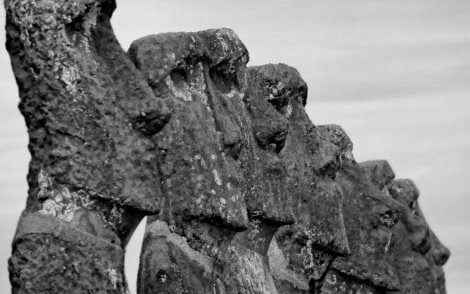
The idea that the moai were the guardians of a remote island and that their colossal size was meant to frighten off possible invaders has found echo in many of the thousands of visitors who come to Easter Island every year.
However, this concept of megalithic statues gazing at the horizon is contradicted by scientific discoveries and knowledge that has always existed among the Rapanui people.
In 1838, the French Captain Abel Du Petit Thouars, commander of the sloop Venus, had the honor of leading the last foreign expedition to see a statue standing on its ceremonial altar on Easter Island.
This statue faced toward the interior, as had all the statues seen previously by European visitors. They were turned toward their people, toward their village and had their backs to the sea.
MYTH: The seven Moai of Ahu Akivi
According to local legends and oral traditions, the number “seven” is not chosen randomly. These Moai’s, who are all about one size, are said to be the seven explorers of the founding father “Hotu Matuá”.
One of several legends states that Prince Matuá was asked by his father to leave the country. Matuá then asked first a shaman who told him that he had sent his soul across the sea and thereby saw a paradise off the coast three small island, which he recognized as his missing grandchildren named “Nui”, “Iti” and “Kaokao” have.
Prince Matua then sent seven scouts across the sea to look for the said paradise and they then found the island of Rapa Nui. In honor of these explorers seven Moai’s have been installed on Ahu Akivi.
The seven Moai of Ahu Akivi are in the interior and not “looking to the sea” but watching over the villages life.
The Moais are fallen
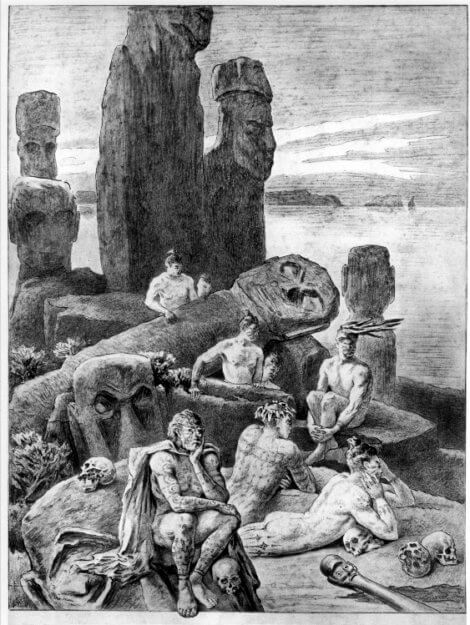
Following the Venus, dozens of ships (mostly whalers) passed by the Island every year without spotting a single statue on the dark, irregular coast.
With the arrival of French Catholic missionaries – the first foreign colonists – on Rapa Nui in the decade of 1860, the Island moved into a new phase. By then, all the Moai were fallen.
The only ones remaining erect were those in the quarry at Rano Raraku and were found half buried. And where did these statues, the largest on the Island, seem to be staring?
At the foot of the slopes of Rano Raraku, the majority of these figures looked toward the plains of the southern coast and, beyond that, to the intense blue of the Pacific Ocean. So the idea, that they “looked to the sea” came to be.
While it is easily explained that a village was situated between the Moai and the ocean, many people even today still call them the “Seven Moai which Look to the Sea”.
In spite of the inland location of the seven Moai of Ahu Akivi at 2.6 kilometers (1.6 miles) from the coast, the desolate and treeless terrain.
~ Excerpt of Moe Varua. The Myth of the Moai “who look toward the Sea”. 2016.
Legend: The collapse of the Moai
~ Story told by Juan Araki to Father Sebastian Englert. 1939.
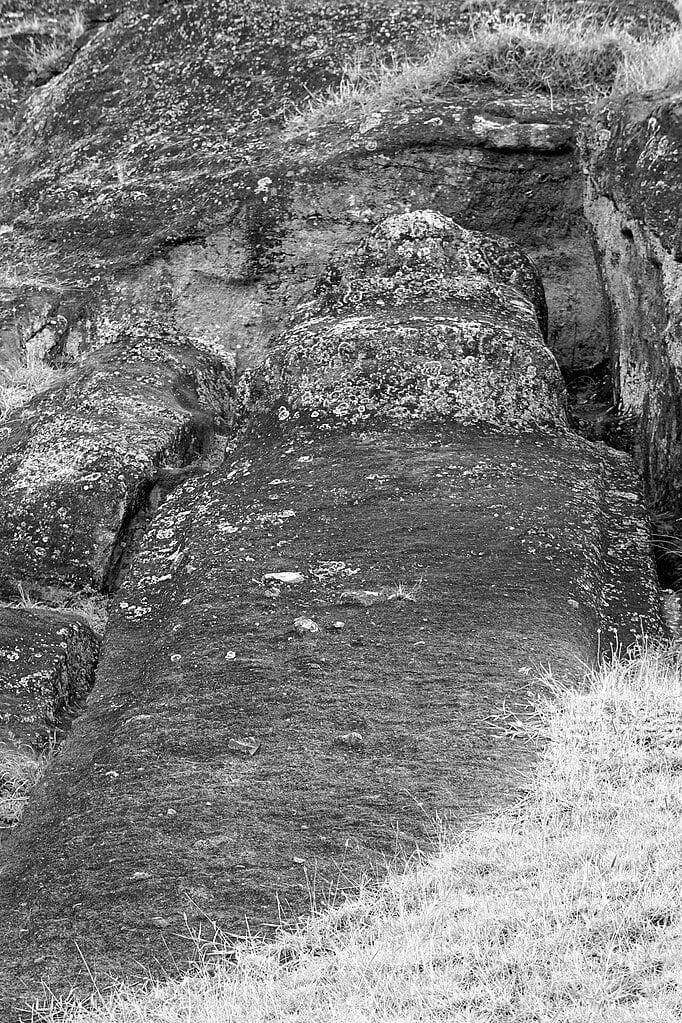
A man went down to the shore. He took a net with him, and jumped into the water. He dived beneath the surface into a hole where there was a lobster.
In the hole, the man could feel the lobster tugging at him from above. He turned around to look. When he saw the lobster above him, he climbed out.
He headed for the beach and said to two men: “Let’s all go into the sea!” The three men jumped in and reached the hole, before diving down. They saw that the lobster had lowered itself from the upper section of the hole.
The three men reached out with their hands, grabbed the lobster, brought it up to the surface, and carried it, swimming, to the shore.
They returned home, cooked the lobster and ate it. It was a very big lobster, with a large abdomen. They ate it all until there was nothing left. When an old lady, who was a cook for the moai workers, came down from above, she said: “Wow, what a lobster! A very big lobster, with a large abdomen! How many of you shared the big lobster? You haven’t even left me a leg!”
When she returned, the old lady shouted to the heavens: “May you all fall over!”
And the moai fell to the ground. The wind howled, there was lighting and the crash of thunder sounded throughout the night. The next day the moai had fallen over. The craftsmen scattered.
Te Tokana was the last moai. No more moai were made after that [according to Arturo Teao, the Te Tokanga was one of the first moai to be made.]
Variant II: The collapse of the Moai
~ Hell Heinz. Mysterious Easter Island Described by a Passenger on Once-a-Year Steamship New York Herald Tribune. 1933.
The ancient myth runs like this :
Once there lived a cook on the rim of the volcano who prepared food for the sculptors, and aided by her magic power, helped create the complete figures wherever she happened to be.
(How else, indeed, could such huge things have been moved?)
One day – the cook was away on an errand – the people brought in from the sea, the body of a delectable shellfish, which the artists, in their greed, seized upon in a voracious manner, eating it up without leaving so much as a tiny piece.
The cook returned from her outing, saw the clean shell, and was overcome with grief at the selfishness of the sculptors. She immediately summoned her magic powers and ordered all the idols round about town tom down.
The work of the stone carvers was suddenly interrupted never to be resumed again – so the people say…
Theories on the decline of the moai and the people:
Around the sixteenth and seventeenth centuries, Rapanui society began to undergo a radical transformation. Production at the quarry on the slopes of Ranu Raraku ground to a halt, those moai that had been mounted on the ahu were taken down, and the religious aristocratic order collapsed. The causes have long been a bone of contention.
The most widely accepted theories refer to a crisis in Rapanui society, brought about by environmental degradation and domestic conflict, prior to the European arrival.
These theories are based on written sources from European explorers, archaeological evidence, and the island’s oral tradition.
- According to some researchers, over exploitation of the environment had far-reaching and disastrous consequences. Possibly the methods used in the construction and transportation of the moai had a calamitous impact on forestry resources. Simultaneously, the increasing population exerted further pressure on an already fragile ecosystem: large expanses of woodland were burned in order to clear them for crop plantation. The deforestation and subsequent soil erosion resulted in a shortage of raw materials for the construction of monuments and ocean-going vessels.
- The delicate situation was further intensified by climatic change, such as the corriente del niño (whereby unusually warm waters come from the north to the colder southern regions), and droughts.
- Further research regards the clashes that occurred between different groups as a decisive factor, owing in part to the shortage of food provisions. This theory is supported by oral tradition, which refers to two groups becoming embroiled in a fierce war: the Hanau momoko and the Hanau e’epe. The stories make several references to violence, persecutions and even cannibalism. These battles resulted in the warrior leaders or matatoa assuming political power.
The moai belonging to the defeated group were pulled down in order to destroy the power with which they had been invested.
An alternative hypothesis suggests that no social crisis had arisen prior to the arrival of Europeans, but that this occurred in the nineteenth century, the result of slavery and the spread of contagious diseases.
- More recently, researchers, such as the archaeologist José Miguel Ramírez, have argued that several factors were responsible for the deepening crisis affecting the island society; these included environmental degradation and clan warfare, but they also maintain that these events had occurred in the context of a long process of transformation and adaptation, rather than a sudden cultural collapse.
- Recent archaeological analyses have also challenged the idea that a famine occurred prior to the arrival of the Europeans. According to the Belgian author and archaeologist, Nicolas Cauwe, who led an expedition that studied the island over 10 years, the moai were laid down following a renouncement of their belief in the ancient deities and the traditional values associated with them. Instead he advanced the notion of a gradual, generational shift, rather than a radical change, under which the ahu assumed the role of tombs, and the statues were used to seal them. Cauwe argues that, if they had been knocked violently to the ground, the impact of several tons of stone hitting the ground would have caused irreparable damage to the moai, which is not in evidence today.
All theories concur with the notion that Rapanui society underwent a major process of change, in which the ancient order was dissolved and then gradually replaced.
Re-erected Moai
Some Moai were re-erected as decoration by the (Chilean) governor Tejeda in 1938, looking toward the sea in the area of Hanga Roa o Tai. One of them, the Moai a Hani was knocked down by a tsunami in 1946.
In October of 1955, a team of archaeologists arrived in the greatest archaeological expedition in the history of the Island, financed by the Norwegian explorer Thor Heyerdahl. The Moai at Ahu Ature Huki was again standing on its stone altar for the first time in 120 years … and it was looking inland. The archaeologist and member of the 1955-56 Heyerdahl expedition, William Mulloy, returned to the Island four years later.
A second phase of archaeological restoration began in the second half of the 1960s, a third at the beginning of the 1970s and at the end of the 70s, Sergio Rapu directed a fourth restoration at Anakena and at the bay of Hanga Roa.
The crowning moment beeing the restoration of Ahu Tongariki, the largest of all with 15 Moai, in the 90s their All moai have their original orientation – facing the interior [, the villages].
These stone giants were created by the Rapa Nui to represent their ancestors or past rulers, who after dying had the ability to extend their mana (spiritual power) over the tribe to protect it.
~ Excerpt of Moe Varua. The Myth of the Moai “who look toward the Sea”. 2016.
~ ○ ~
Keep exploring:
Works Cited & Multimedia Sources
- Barkcloth Figure & Male Figure. 2017. http://mappingoceania.org/polynesia/barkcloth-figure-male-figure/
- Barkcloth figure. Photograph. Photograph from Peabody Museum of Archeology and Ethnography. https://www.peabody.harvard.edu/node/2064
- Barthel Thomas S. The Eighth Land: The Polynesian Settlement of Easter Island. 1978. http://archive.hokulea.com/ike/moolelo/hotu_matua.html
- Boyd Films Laura Jean. Mythologizing the History of Easter Island Through Documentary. In: Rapa Nui Journal Vol. 21. 2010. http://islandheritage.org/wordpress/wp-content/uploads/2010/06/RNJ_21_1_Boyd.pdf
- Buck Peter H. Vikings of the Pacific. University of Chicago Press. 1938. http://archive.hokulea.com/holokai/geography/1999_islands/rapanui.html
- Chauvet Stéphen. Easter Island and Its Mysteries. Translated by Ann M. Altman, edit. Shawn McLaughlin. First published in 1935. http://www.chauvet-translation.com/carved.htm
- Christine Gleisner, Sara Montt (Unidad de Cultura, Fucoa) rapanui serie introducción histórica y relatos de los pueblos originarios de chile historical overview and tales of the indigenous peoples of chile. https://www.fucoa.cl/publicaciones/pueblos_originarios/rapanui.pdf
- Craig Robert D. Handbook of Polynesian Mythology. 2004.
- Easter Island or (Man-) Eaters Island? Pau/G. Bahn. Vol II (3) September 1997 http://islandheritage.org/wordpress/wp-content/uploads/2010/06/RNJ_11_3_Bahn.pdf
- Englert, S. Tradiciones de la Isla de Pascua en idioma rapanui y castellano. Padre Las Casas: Printing San Francisco. 1939.
- Expedition of the seven explorers. http://chileprecolombino.cl/en/arte/narraciones-indigenas/rapa-nui/expedicion-de-los-siete-exploradores/
- expedition of the seven explorers. http://chileprecolombino.cl/en/arte/narraciones-indigenas/rapa-nui/expedicion-de-los-siete-exploradores/
- Hell Heinz. Mysterious Easter Island Described by a Passenger on Once-a-Year Steamship New York Herald Tribune, 1933. In: Rapa Nui Journal 58 Vol. 22. 2008. http://islandheritage.org/wordpress/wp-content/uploads/2010/06/RNJ_22_1_Heinz_Hell.pdf
- History of Easter Island. Rapa Nui mythology. From Wikipedia, the free encyclopedia. https://en.wikipedia.org/wiki/History_of_Easter_Island#The_%22statue-toppling%22
- Hjva Rapanui Ancient Song and Dance of Easter Island Steven Roger Fj cher, Ph.D. Auckland, New Zealand. Vol II (4) December 1997. http://islandheritage.org/wordpress/wp-content/uploads/2010/06/RNJ_11_4_Moai.pdf
- https://en.wikipedia.org/wiki/Rapa_Nui_mythology
- Lee Georgia, Ika Keremo. Petroglyphs and Legends of Rapa Nui. Vol. 13 (3) September 1999. http://islandheritage.org/wordpress/wp-content/uploads/2010/06/RNJ_13_4_Lee_Ika.pdf
- Legends and mythology. https://www.easterisland.travel/easter-island-facts-and-info/legends-and-mythology/
- Luomala Katharine. Moving and movable images in Easter Island custom and myth. The Journal of Polynesian Society. Volume 82. 1973. http://www.jps.auckland.ac.nz/document/Volume_82_1973/Volume_82%2C_No._1/Moving_and_movable_images_in_Easter_Island_custom_and_myth%2C_by_Katharine_Luomala%2C_p_28-46/p1?page=0&action=searchresult&target=
- Mc Coyby Patrick C. The place of near-shore islets in Easter Island prehistory. The Journal of Polynesian Society. Volume 87.1978. http://www.jps.auckland.ac.nz/document/Volume_87_1978/Volume_87%2C_No._3/The_place_of_near-shore_islets_in_Easter_Island_prehistory%2C_by_Patrick_C._McCoy%2C_p_193-214/p1?page=0&action=searchresult&target=#
- Moai statues. https://www.easterisland.travel/easter-island-facts-and-info/moai-statues/
- More Journals on Easter Island: The works or Johann Reinhold Forster (171.9-1798) and Johann George Adam Forster (1754-1794) [ Herbert von Saber. Vol 6, No 2· Page 34.] Rapa_Nui_Journal_6_2_June_1992.pdf
- Mulloy Ross Emily. The Long and Short ofit: Some Thoughts on the Meaning of the Names hanau eepe and hanau momoko in Rapanui Tradition. Laramie, Wyoming. Vol 7 (4) December 1993. https://web.archive.org/web/20140923212411/http://islandheritage.org/wordpress/wp-content/uploads/2010/06/Rapa_Nui_Journal_7_4_December_1993.pdf
- Mulloy William. Contemplate The Navel of the World, originally appeared in Americas VoL 26:4 1974. Rapa_Nui_Journal_5_2_Summer_1991.pdf
- Rapa Nui Journal. Vo 16 No2. 1992. Rapa_Nui_Journal_6_2_June_1992.pdf
- Routledge Katherine Pease. The mystery of Easter island; the story of an expedition. 1919. https://archive.org/details/mysteryofeaster00rout
- The Birdman Motif of Easter Island. http://www.bradshawfoundation.com/easter/birdman_motif_easter_island.php
- The Sooty Tern and its Role in Easter Island’s Birdman Ceremony. https://blogpatagonia.australis.com/sooty-tern-birdman-ceremony/
- The View of Woman in Rapanui Society Part 1. Women in Myths and Legends 1 Ana Maria Arredondo. Vol. 14 (2) June 2000. Journal. 2010.pdf. Journal 2010/06/RNJ_14_3_Arredondo.pdf
- Trachtman Paul. The Secrets of Easter Island. The more we learn about the remote island from archaeologists and researchers, the more intriguing it becomes. Smithsonian Magazine. 2002. https://www.smithsonianmag.com/history/the-secrets-of-easter-island-59989046/#6jPqV5i77XtzC4ts.99
- Van Tilburg Jo Anne. Facts About Rapa Nui (Easter Island). Easter Island statue project. http://www.eisp.org/120/
- Walking Moai? Ferren MacIntyre MRI, National University ofIreland, Galway. Vol. 13 (3) September 1999. Journal 2010/06/RNJ_13_3_MacIntyre.pdf
- William Mulloy. In: Rapa Nui Journal Vol. 26. 2008. Islandheritage Journal
- http://www.art-and-archaeology.com/timelines/oceania/birdman.pdf

